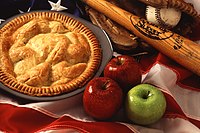| Revision as of 21:55, 11 September 2010 editNihil novi (talk | contribs)Autopatrolled, Extended confirmed users56,586 edits →Language and cultural neutrality← Previous edit | Revision as of 22:01, 11 September 2010 edit undoNihil novi (talk | contribs)Autopatrolled, Extended confirmed users56,586 edits copyeditNext edit → | ||
| Line 2: | Line 2: | ||
| :''For other uses of the term see ]. For a list of icons for use on Misplaced Pages, see ].'' | :''For other uses of the term see ]. For a list of icons for use on Misplaced Pages, see ].'' | ||
| ] ]s |
] ]s]] | ||
| ], iconic of the government of the ] |
], iconic of the government of the ]]] | ||
| ] graphic is not an icon but a ], because its meaning is purely ]al, and it represents no specific object.]] | |||
| A '''secular icon''' is an image or pictograph of a person or thing used for other than religious purpose. (See ] for such use.) | A '''secular icon''' is an image or pictograph of a person or thing used for other than religious purpose. (See ] for such use.) | ||
Revision as of 22:01, 11 September 2010
| This article does not cite any sources. Please help improve this article by adding citations to reliable sources. Unsourced material may be challenged and removed. Find sources: "Secular icon" – news · newspapers · books · scholar · JSTOR (October 2006) (Learn how and when to remove this message) |
- For other uses of the term see Icon (disambiguation). For a list of icons for use on Misplaced Pages, see Misplaced Pages:Icons.



A secular icon is an image or pictograph of a person or thing used for other than religious purpose. (See icon for such use.)
Icons versus symbols
- An icon is a graphic device that represents some object or action, the graphic device being ascribed symbolic meaning(s) beyond the object represented.
- A symbol has only the meanings ascribed to itself, representing only a concept and not recognizable as a particular object.
Language and cultural neutrality
International standards have been developed to harmonize icons and symbols. The latter can be seen particularly at international airports and on roadside signs, to assist travelers. Icons are also becoming standardised for consumer electronics and for automobile controls.
Warning symbols, such as the biological-hazard, or biohazard, symbol, are sometimes not self-explanatory but are well-known within the relevant art or craft; they are not icons, but symbols.
Political and governmental iconic symbols
Secular icons are seen particularly in editorial cartoons, where a simple image can be used to represent a complex concept or entity. These are often cultural specific, as recognition of some symbols may depend upon a deep understanding of the current local situation and the players involved, while others are so common that they are understood over a wide range of cultures (but not worldwide). Edifices such as the United States Capitol Building or the White House, the Tower of Westminster, and Saint Basil's Cathedral have become representations respectively of the Governments of the United States of America, Great Britain, and Russia. Other symbols (such as the bald eagle for the United states, the bear for Russia, or the chinese dragon for China) are used to represent nations, as distinct from (yet inclusive of) governments.
Modern computer systems
Main article: Icon (computing)Modern personal computers and control systems make extensive use of icons in the form of small images representing such objects as file folders, documents and applications within a graphical user interface.
See also
- Cultural icon
- Gay icon
- Semeiotics, the analysis of icons and symbols.
- Symbol